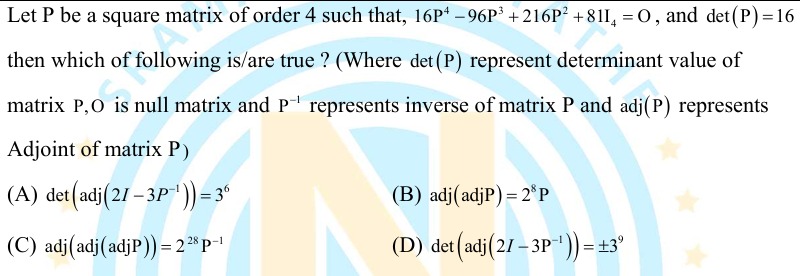Question
Question: Let P be a square matrix of order 4 such that, $16P^4 - 96P^3 + 216P^2 + 81I_4 = O$, and det(P) = 16...
Let P be a square matrix of order 4 such that, 16P4−96P3+216P2+81I4=O, and det(P) = 16 then which of following is/are true? (Where det(P) represent determinant value of matrix P, O is null matrix and P−1 represents inverse of matrix P and adj(P) represents Adjoint of matrix P)

det(adj(2I−3P−1)) = 36
adj(adjP) = 28P
adj(adj(adjP)) = 228P−1
det(adj(2I−3P−1)) = ±39
(B), (C), (D)
Solution
Let the given matrix equation be
16P4−96P3+216P2+81I4=O
This equation can be rewritten as:
16P4−96P3+216P2+0P+81I=O
Since det(P)=16=0, P is invertible, so P−1 exists.
From (2P−3I)4=−216P, take the determinant:
det((2P−3I)4)=det(−216P)
(det(2P−3I))4=det(−216I⋅P)=det(−216I)det(P)
(det(2P−3I))4=(−216)4det(P) (since order is 4)
(det(2P−3I))4=(−(23×33))4×16=(23×33)4×24=212×312×24=216×312.
det(2P−3I)=±(216×312)1/4=±24×33=±16×27=±432.
Let's consider the expression 2I−3P−1.
We need to find det(adj(2I−3P−1))=(det(2I−3P−1))3.
Let A=2I−3P−1.
AP=(2I−3P−1)P=2P−3I.
A=(2P−3I)P−1.
det(A)=det((2P−3I)P−1)=det(2P−3I)det(P−1)=det(2P−3I)/det(P).
We know det(P)=16. So det(A)=det(2P−3I)/16.
det(A)=det(2I−3P−1)=det(2P−3I)/16=(±432)/16=±27.
Now, det(adj(2I−3P−1))=(det(2I−3P−1))3=(±27)3=(±33)3=±(33)3=±39.
So, option (D) det(adj(2I−3P−1))=±39 is true.
(B) adj(adjP) = 28P.
For an n×n matrix P, adj(adjP) = (det(P))n−2P.
Here n=4.
adj(adjP) = (det(P))4−2P=(det(P))2P.
Given det(P)=16.
adj(adjP) = (16)2P=(24)2P=28P.
So, option (B) adj(adjP) = 28P is true.
(C) adj(adj(adjP)) = 228P−1.
Let Q=adj(adjP). We found Q=(det(P))2P=162P.
Now we need to find adj(Q) = adj(162P).
adj(kM) = kn−1 adj(M) for an n×n matrix M and scalar k.
Here k=162=(24)2=28, M=P, n=4.
adj(162P) = (162)4−1 adj(P) = (162)3 adj(P) = 166 adj(P).
We know that adj(P) = det(P)P−1.
adj(adj(adjP)) = 166(det(P)P−1)=166(16P−1)=167P−1.
167=(24)7=228.
So, adj(adj(adjP)) = 228P−1.
Option (C) adj(adj(adjP)) = 228P−1 is true.
The question asks which of the following is/are true. Options (B), (C), and (D) are true.
